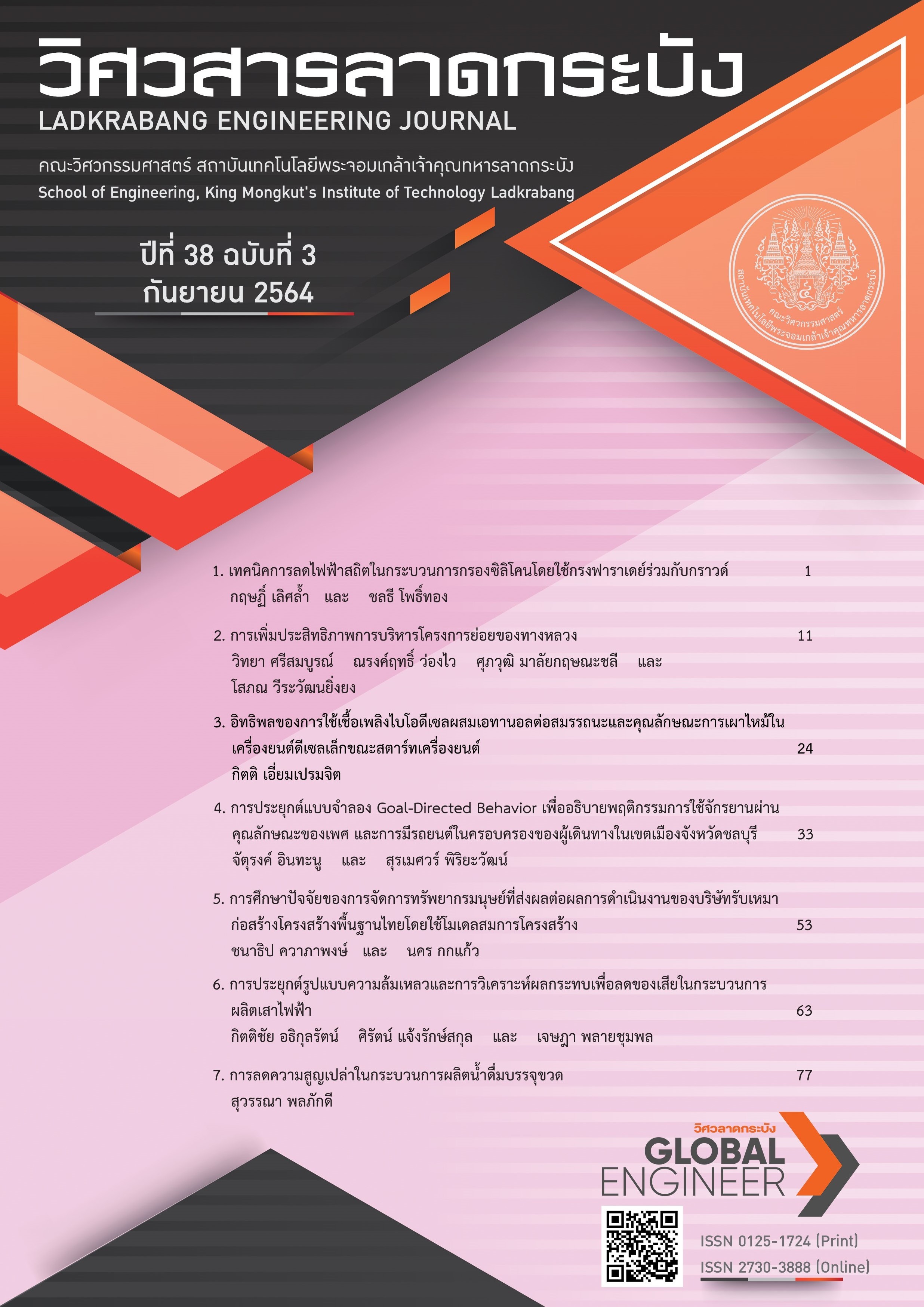Performance Enhancement of Highway Subproject Management
Keywords:
Highway Subproject, Multi-Criteria Decision Analysis, Prioritization, Strategic RouteAbstract
Highway subprojects have numerous activities; therefore, it is very complicated to allocate the annual budget. Nowadays, project prioritization criteria still need to be updated following engineering economic principles, in order that the budget allocation can actually fulfill the people's requirements. This research applied multi-criteria decision analysis for developing project prioritization to analyze ten years subproject plan. The proposed method can save 16,324 million baht (17%) of annual government statement of expenditure, produce beneficial for 199,975 households, develop 4,503 community activities centers, solve 5,477 problems and develop 2,890 strategic routes.
References
S. Mardle, S. Pascoe and I. Herrero, “Management objective importance in fisheries: An evaluation using the analytic hierarchy process (AHP),” Environmental Management, vol. 3, no. 1, pp. 1–11, Feb., 2004, doi: 10.1007/s00267-003-3070-y.
K. Nosal and K. Solecka, “Application of AHP method for multi-criteria evaluation of variants of the integration of urban public transport,” Transportation Research Procedia, vol. 3, pp. 269–278, 2014, doi: 10.1016/j.trpro.2014.10.006.
S. Erna, A. Subandiyah and I. Tiong, “Priority Scale Analysis Using Analytical Hierarchy Process (AHP) to Determine Traditional Market Development in Tulungagung District,” International Journal of Scientific Engineering and Science, vol. 2, no. 9, pp. 31–37, 2018.
T. Arundon and O. Wang-a-pisit, “The prioritization on road investment projects in Songkhla,” UBU Engineering Journal, vol. 14, no. 1, pp. 115–128, 2020.
A. Rakan and L. Suzanna, “The Application of Fuzzy Analytic Hierarchy Process in Sustainable Project Selection,” Sustainability, vol. 12, no. 20, pp.1–16, 2020, doi: 10.3390/su12208314 .
V. Juliana, C. Ricardo, Y. Akebo and V. Wesley, “Using the Fuzzy Sets Theory in the Multimodal Transport Network Problem,” in Proc. IFSA World Congress and NAFIPS Annual Meeting (IFSA/NAFIPS), Edmonton, AB, Canada, Jun. 24–28, 2013, doi: 10.1109/IFSA-NAFIPS.2013.6608503.
A. Erel, P. Joseph and C. Avishai , “Transportation projects selection process using fuzzy sets theory,” Fuzzy Sets and Systems, vol. 116, no. 1, pp. 35–47, 2000, doi: 10.1016/S0165-0114(99)00036-6.
P. Luis, A. Sara-Nohemí, R. Roberto, P. Iván Juan Carlos , L.David and H. Jesús Andrés, “Assessment Urban Transport Service and Pythagorean Fuzzy Sets CODAS Method: A Case of Study of Ciudad Juárez,” Sustainability, vol. 13, no. 3, pp. 1–18, 2021, doi: 10.3390/su13031281.
A. Adesanya, “Decision-making for sustainable transport and mobility: Multi actor multi criteria analysis,” The Social Science Journal, vol.58, no. 2, pp. 268–269, 2020, doi: 10.1080/03623319.2020.1795520.
H. Purboyo, P. Pradono and H. Titus, “Development of Multi-Actor Multi-Criteria Analysis Based on the Weight of Stakeholder Involvement in the Assessment of Natural-Cultural Tourism Area Transportation Policies,” Algorithms, vol. 14, no. 7, pp. 1¬–22, 2021, doi: 10.3390/a14070217.
L. Maria, B.Geert, M. Cathy and C. Thierry, “Application of Multi-Actor Multi-Criteria Analysis for Transition Management in Energy Communities,” Sustainability, vol. 13, no. 4, pp.1–18, 2021, doi: 10.3390/su13041783.
H. Tezcan UYSAL and Y. Kemal , “Selection of Logistics Centre Location via ELECTRE Method: A Case Study in Turkey,” International Journal of Business and Social Science, vol. 5, no. 9, pp.276–289, 2014.
F. Mohamed and M. Soha, “A New ELECTRE-II Approach Using Separation Method And Grey Subjective-Objective Weights' Allocation Scheme,” International Journal of Scientific & Technology, vol. 9, no. 1, pp. 3251–3257, 2020.
J. Praveena and M. Devi, “Electre Method in Selection of a Seventh Party Logistics Provider (7pl),” International Journal of Engineering and Advanced Technology (IJEAT), vol. 9, no.4, pp.173¬–176, 2020, doi: 10.35940/ijeat.C6518.049420.
A. Hakan, “Sector Analysis of Turkish Markets using the PROMETHEE Method,” Journal of Business, Economics and Finance, vol. 9, no. 3, pp.196-208, 2020, doi 10.17261/PRESSACADEMIA.2020.1296.
M. Maria and P. Jason, “Use of PROMETHEE MCDA Method for Ranking Alternative Measures of Sustainable Urban Mobility Planning,” Mathematics, vol. 9, no. 6, pp.1¬–15, 2021, doi: 10.3390/math9060602.
O. Laila and D. Szabolcs, “Review of PROMETHEE method in transportation,” Production Engineering Archives, vol. 27, no. 1, pp.69–74, 2021, doi: 10.30657/pea.2021.27.9.
I. Linkov, F. Satterstrom, G. Kiker, T. Seager, T. Bridges, K. Gardner, S. Rogers, D. Belluck and A. Meyer, “Multicriteria Decision Analysis: A Comprehensive Decision Approach for Management of Contaminated Sediments,” Risk Analysis, vol. 26, no. 1, pp. 61–78, 2006, doi: 10.1111/j.1539-6924.2006.00713.x.
J. Jia, G. Fischer and J. Dyer, “Attribute Weighting Methods and Decision Quality in the Presence of Response Error: A Simulation Study,” Journal of Behavioral Decision Making, vol.11, no. 2, pp. 85–105, 1998, doi: 10.1002/(SICI)1099-0771(199806)11:2<85::AID-BDM282>3.0.CO;2-K.
M. K. William, “Likert Scaling,” in Research Methods Knowledge Base, 2nd Edition, Cincinnati, Ohio, United States of America: A.D.P., 2006, ch. 4, sec. 5, pp. 163-165 .
M. Shanmuganathan, K. Kajendran, A. Sasikumar and M. Mahendran, “Multi Attribute Utility Theory- An Over View,” International Journal of Scientific & Engineering Research , vol. 9, no. 3, pp.698–706, 2018.
Freight Transport Bureau, Department of Land Transport, “Truck Data Service Center,” Freight Transport Bureau, Department of Land Transport, Jul. 2021 [Online]. Available: https://www.thaitruckcenter.com/tdsc/
Downloads
Published
How to Cite
Issue
Section
License
Copyright (c) 2021 Faculty of Engineering, King Mongkut’s Institute of Technology Ladkrabang

This work is licensed under a Creative Commons Attribution-NonCommercial-NoDerivatives 4.0 International License.
The published articles are copyrighted by the School of Engineering, King Mongkut's Institute of Technology Ladkrabang.
The statements contained in each article in this academic journal are the personal opinions of each author and are not related to King Mongkut's Institute of Technology Ladkrabang and other faculty members in the institute.
Responsibility for all elements of each article belongs to each author; If there are any mistakes, each author is solely responsible for his own articles.






